
The Central line is a London Underground line that runs through central London, from Epping, Essex, in the north-east to Ealing Broadway and West Ruislip in west London. Printed in red on the Tube map, the line serves 49 stations over 46 miles (74 km), making it the longest line on the Underground. It is one of only two lines on the Underground network to cross the Greater London boundary, the other being the Metropolitan line. One of London's deep-level railways, Central line trains are smaller than those on British main lines.

The Metropolitan line, colloquially known as the Met, is a London Underground line between Aldgate in the City of London and Amersham and Chesham in Buckinghamshire, with branches to Watford in Hertfordshire and Uxbridge in Hillingdon. Printed in magenta on the tube map, the line is 41.4 miles (66.7 km) in length and serves 34 stations. Between Aldgate and Finchley Road, the track is mostly in shallow "cut and cover" tunnels, apart from short sections at Barbican and Farringdon stations. The rest of the line is above ground, with a loading gauge of a similar size to those on main lines. Just under 94 million passenger journeys were made on the line in 2019.

Metro-Cammell, formally the Metropolitan Cammell Carriage and Wagon Company (MCCW), was an English manufacturer of railway carriages, locomotives and railway wagons, based in Saltley, and subsequently Washwood Heath, in Birmingham. The company was purchased by GEC Alsthom in May 1989; the Washwood Heath factory closed in 2005 and was demolished in early 2019.

The Metropolitan Railway was a passenger and goods railway that served London from 1863 to 1933, its main line heading north-west from the capital's financial heart in the City to what were to become the Middlesex suburbs. Its first line connected the main-line railway termini at Paddington, Euston, and King's Cross to the City. The first section was built beneath the New Road using cut-and-cover between Paddington and King's Cross and in tunnel and cuttings beside Farringdon Road from King's Cross to near Smithfield, near the City. It opened to the public on 10 January 1863 with gas-lit wooden carriages hauled by steam locomotives, the world's first passenger-carrying designated underground railway.
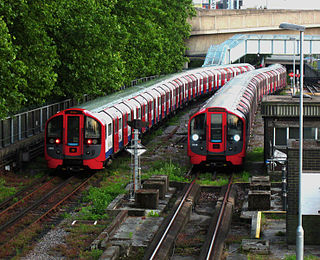
London Underground rolling stock includes the electric multiple-unit trains used on the London Underground. These come in two sizes, smaller deep-level tube trains and larger sub-surface trains of a similar size to those on British main lines, both running on standard gauge tracks. New trains are designed for the maximum number of standing passengers and for speed of access to the cars.

The Metropolitan District Railway, also known as the District Railway, was a passenger railway that served London, England, from 1868 to 1933. Established in 1864 to complete an "inner circle" of lines connecting railway termini in London, the first part of the line opened using gas-lit wooden carriages hauled by steam locomotives. The Metropolitan Railway operated all services until the District Railway introduced its own trains in 1871. The railway was soon extended westwards through Earl's Court to Fulham, Richmond, Ealing and Hounslow. After completing the inner circle and reaching Whitechapel in 1884, it was extended to Upminster in Essex in 1902.

The Southern Railway (SR) gave the designation 2-BIL to the DC third rail electric multiple units built during the 1930s to work long-distance semi-fast services on the newly electrified lines from London to Eastbourne, Portsmouth and Reading. This type of unit survived long enough in British Rail ownership to be allocated TOPS Class 401.

The history of the London Underground began in the 19th century with the construction of the Metropolitan Railway, the world's first underground railway. The Metropolitan Railway, which opened in 1863 using gas-lit wooden carriages hauled by steam locomotives, worked with the District Railway to complete London's Circle line in 1884. Both railways expanded, the Metropolitan eventually extending as far as Verney Junction in Buckinghamshire, more than 50 miles (80 km) from Baker Street and the centre of London. The first deep-level tube line, the City and South London Railway, opened in 1890 with electric trains. This was followed by the Waterloo & City Railway in 1898, the Central London Railway in 1900, and the Great Northern and City Railway in 1904. The Underground Electric Railways Company of London (UERL) was established in 1902 to fund the electrification of the District Railway and to complete and operate three tube lines, the Baker Street and Waterloo Railway, the Charing Cross, Euston and Hampstead Railway and the Great Northern, Piccadilly and Brompton Railway, which opened during 1906–1907. By 1907, the District and Metropolitan Railways had electrified the underground sections of their lines.
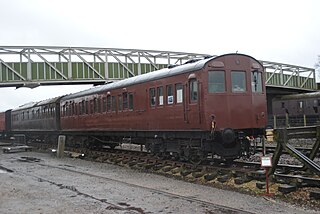
The T Stock was a series of electric trains originally built in various batches by Metropolitan-Vickers and the Birmingham Railway Carriage and Wagon Company for the Metropolitan Railway in 1927–31 for use on electric services from Baker Street and the City to Watford and Rickmansworth, though rarely some worked on the Uxbridge branch.

The London Underground coaching stock is the coaching stock of the London Underground in London, United Kingdom.

The Metropolitan Railway E Class is a class of 0-4-4T steam locomotives. A total of seven locomotives were built between 1896 and 1901 for the Metropolitan Railway: three by the railway at their Neasden Works and four by Hawthorn Leslie and Company in Newcastle upon Tyne.
Push–pull is a configuration for locomotive-hauled trains, allowing them to be driven from either end of the train, whether having a locomotive at each end or not.

An electric multiple unit (EMU) is an electric self-powered train, capable of operating in multiple with other EMUs and without the need for a locomotive; these are typically passenger trains with accommodation in every vehicle and a driving position at each end. The term can also be used to describe a train that is a permanent formation with a non-driving power car, such as the Advanced Passenger Train. As of December 2010, two-thirds of the passenger carriages in Great Britain are formed in EMUs.
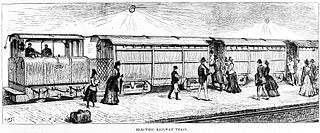
Electric locomotives were first used on the London Underground when the first deep-level tube line, the City and South London Railway (C&SLR), was opened in 1890. The first underground railways in London, the Metropolitan Railway (MR) and the District Railway (DR), used specially built steam locomotives to haul their trains through shallow tunnels which had many ventilation openings to allow steam and smoke to clear from the tunnels. It was impractical to use steam locomotives in the small unvented tubular tunnels of the deep-level lines, and the only options were rope haulage or electric locomotives.
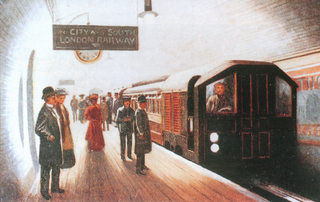
The Central London Railway Stock were electric multiple units composed of trailers that had been converted from carriages designed to be hauled by electric locomotives with new motor cars. The Central London Railway opened in 1900 with electric locomotives hauling wooden carriages, but the heavy locomotives caused vibrations that could be felt in the buildings above the route. It was found that conversion to electric multiple units solved the problem, so new motor cars were bought and replaced all the locomotives by June 1903. Trains normally ran with six-cars, four trailers and two motor-cars. Some trailers were equipped with control equipment to allow trains to be formed with three cars.
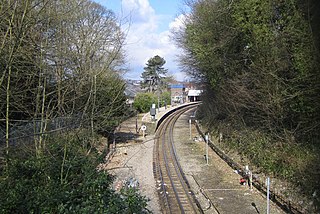
The Chesham branch is a single-track railway branch line in Buckinghamshire, England, owned and operated by the London Underground. It runs from a junction at Chalfont & Latimer station on the Metropolitan line for 3.89 miles (6.26 km) northwest to Chesham. The line was built as part of Edward Watkin's scheme to turn his Metropolitan Railway (MR) into a direct rail route between London and Manchester, and it was envisaged initially that a station outside Chesham would be an intermediate stop on a through route running north to connect with the London and North Western Railway (LNWR). Deteriorating relations between the MR and LNWR led to the MR instead expanding to the northwest via Aylesbury, and the scheme to connect with the LNWR was abandoned. By this time much of the land needed for the section of line as far as Chesham had been bought. As Chesham was at the time the only significant town near the MR's new route, it was decided to build the route only as far as Chesham, and to complete the connection with the LNWR at a future date if it proved desirable. Local residents were unhappy at the proposed station site outside Chesham, and a public subscription raised the necessary additional funds to extend the railway into the centre of the town. The Chesham branch opened in 1889.
London's Metropolitan Railway (MR) amalgamated with other underground railways, tramway companies and bus operators on 1 July 1933, to form the London Passenger Transport Board (LPTB); the MR became the Board's Metropolitan line.

Metropolitan Railway electric multiple units were used on London's Metropolitan Railway after the lines were electrified in the early 20th century.

The history of the District line started in 1864 when the Metropolitan District Railway was created to create an underground 'inner circle' connecting London's railway termini. The first part of the line opened using Metropolitan Railway gas-lit wooden carriages hauled by steam locomotives. The District introduced its own trains in 1871 and was soon extended westwards through Earl's Court to Fulham, Richmond, Ealing and Hounslow. After completing the 'inner circle' and reaching Whitechapel in 1884, it was extended to Upminster in East London in 1902. To finance electrification at the beginning of the 20th century, American financier Charles Yerkes took it over and made it part of his Underground Electric Railways Company of London (UERL) group. Electric propulsion was introduced in 1905, and by the end of the year electric multiple units operated all of the services.





















